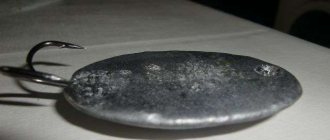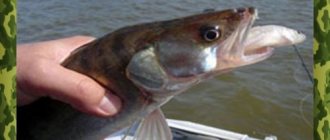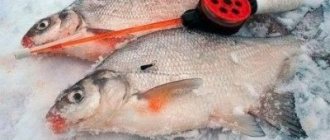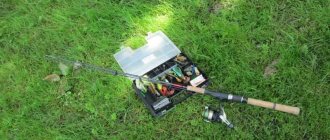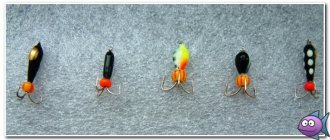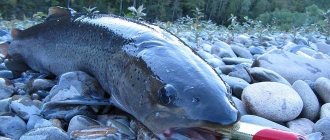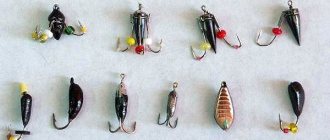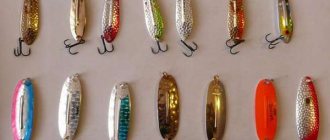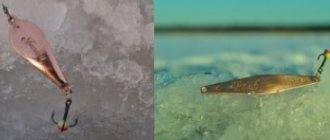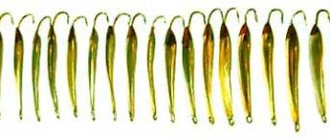Using bottom tackle is one of the most successful ways to catch pike perch.
The main advantages of donka:
- Possibility of simultaneous catching and feeding fish.
- Thanks to the use of a donkey , you can catch a predator in unfavorable weather. Despite strong gusts of wind, the bite is detected by an alarm or a bell.
- Casting over the longest distances (from 80 meters).
- Possibility of catching predators in reservoirs with different depths , as well as in the presence of both strong and weak currents.
When assembling tackle, you should pay close attention to the quality of the parts and not try to save money by purchasing analogues in a cheaper price range. When fishing for large fish, this equipment cannot cope with the load and leaves unpleasant emotions from equipment breaking at the most inopportune moment.
Fishing tackle
- Fishing rod – an excellent option would be a telescopic spinning rod model made of high-quality fiberglass. A suitable rod length is in the range of 2.5-3 meters, and the test is much larger than the total mass of the bait and feeder. For reservoirs with a small current, a test characteristic of 40-60 grams is suitable, but for strong currents it is better to opt for models with a test value exceeding 100 grams.
- The reel is an inertia-free type with a spool size of 3000. The capacity of the reel should not be less than 100 m of fishing line. The presence of a friction clutch and a built-in “baitrunner” system when fishing for pike perch is only welcome.
- Fishing line – given the likelihood of catching large specimens of predatory fish , it is advisable to use monofilament with a diameter of 0.32 mm.
- A feeder is a fairly useful fishing product that delivers a bait mixture to the fishing site and acts as a sinker. A high-quality device keeps the bait in one place, despite the strong current. Cheaper analogues cannot have a holding effect and the bait simply walks around the pond. When choosing the shape of the feeder, you should pay attention to the fishing location.
- Hooks – an excellent option would be to purchase hooks No. 8-10 with a sharp tip and a long shank. The sharpness of the hook has a direct impact on the hooking ability of the fish. Good quality products have a self-hooking effect, which makes the whole process very easy for the fisherman.
- A bite alarm is a fairly useful device that can convey information about a bite to an angler. If desired, you can use both electronic alarms and bells.
- Sinker - used exclusively in case of insufficient weight of the feeder. The product is selected with a weight not exceeding 40 grams. The drop-shaped shape of the weight allows casting to the longest possible distance, which has earned it popularity among professional fishermen.
- A stand is a necessary device for catching pike perch on a donk. Single racks are used when fishing with one rod. If there is several gears, then it is more advisable to purchase a stand called a “pod”.
For fishing on lakes and reservoirs with minimal current, feeders of the following shape are suitable:
- spring;
- nipple shape;
- banjo and cages;
If fishing is carried out in reservoirs with strong currents, it is recommended to use square and triangular type feeders. This category of products behaves quite steadily in the current.
https://www.youtube.com/watch?v=PQd-AuP1eoA
Choosing a place and fishing tactics
Pike perch, like other predators, have their favorite concentration points:
- Boundaries of dumps to depth.
- Strong current.
- Smooth transitions from shallows to depth.
A promising location may be a steep coastline with a turbulent whirlpool and a reverse current. It is at such points that you can expect a bite from a test or trophy specimen.
Fishing from the shore
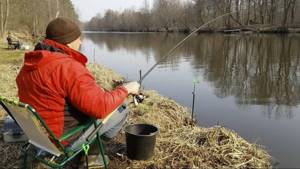
Before installing the gear, you need to inspect the prospects of the coastal edge. It must be cleared of vegetation and bushes. Access to the water must be free for comfortable fishing for the trophy. Having installed bottom gear and provided it with various alarms, constant monitoring is needed. The predator’s bite is almost always sharp, with a short interval: you can’t hesitate.
Pike perch are rarely hooked on their own. Winning a trophy occurs more calmly. The fanged one freezes on the hook and is easily inserted into the landing net.
How to fish with a donkey from a boat
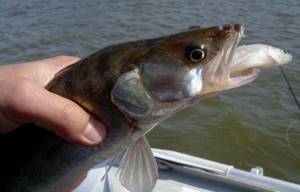
Bottom fishing from a boat takes place at great depths, a bit reminiscent of vertical fishing for pike perch. It works effectively in deep holes, in places where long casting is not needed.
On a note! In deep places, pike perch often inhabit snags and rocky rubble. Fishing sometimes takes place in such difficult-to-pass locations, so you need to have a special hook with you.
For fishing from a boat, you can use a short spinning rod or a simple reel. Various alarms work well. Bells are effective during the day. At night, fireflies are placed.
Features of fishing on the current
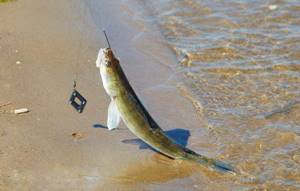
Catching pike perch on a donk can also be productive in the presence of a current. Being constantly on the move, the predator is forced to eat more. You can fish even on relatively fast rivers. It is important to consider the depth and speed of water movement. You need to experiment with the weight of the load. Flat weights should be selected. They lie well on the bottom, do not roll and hold the tackle at a promising point.
We recommend reading: Winter fishing for bream on a float
Installation of gear
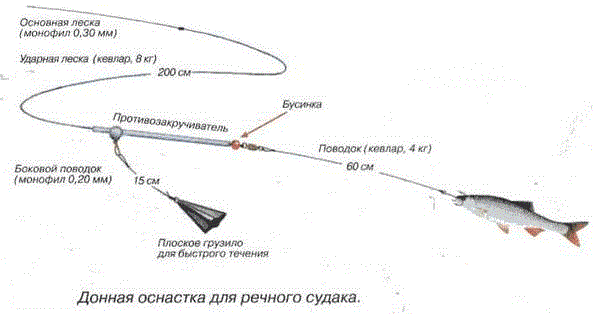
In order not to get confused when assembling the gear, it is recommended to use the following instructions:
- The first step is to assemble the rod. When using a telescopic type of tackle, it is necessary, starting from the tip, to extend all the knees. At the same time, the line of access rings is monitored. It is very important that all rings are located at the same level.
- Before assembling the plug-type gear, you must thoroughly clean all joining points from dust deposits and start connecting all parts of the fishing rod. After this, you can install the coil. To do this, the mechanism is fixed in a place designated for this purpose and screwed with nuts. Using a special lever, we click and set up the device for work.
- Let's move on to the procedure for winding the fishing line. For these purposes, the end of the fishing line is pulled through all the available passage rings (you should start from the top). We make a loop and open the line laying arc. Then we install the fishing line on the spool of the mechanism and close the arc of the fishing line. Slowly, we begin to rotate the reel while holding the handle. During the winding process, it is imperative to prevent the occurrence of possible notches or weakening.
- When starting to make leashes, you should stock up on small pieces of fishing line and hooks with a sharp sting. One end of the fishing line is equipped with a loop, and the other with a hook. Before tightening the knot, you need to thoroughly wet the line. This will allow the knot to be as strong as possible.
- To secure the feeder, you should use the popular Paternoster equipment. To make it you will need: a feeder, a swivel, monofilament, hooks and fluorocarbon fishing line.
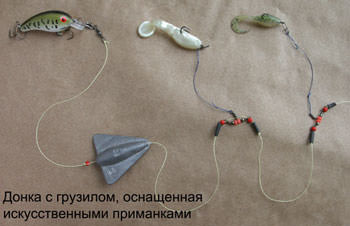
You can link equipment using the following system:
- We measure 45-50 cm of monofilament and cut it from the total skein.
- Fold the fishing line in half , observing the necessary condition - one end should be 10 cm larger than the other.
- We attach a swivel to the fishing line using the throwing method.
- The swivel is equipped with a feeder.
- We firmly tie a knot 10 cm below the swivel.
- The ends of the fishing line are equipped with small loops.
- Let's take another line. We measure 100 cm and cut it off.
- One end of the fishing line is equipped with a hook , and the other with a small loop.
- We attach the leash with the long end of the loop where the feeder is connected using the “loop to loop” method.
- The main line with the short end of the line is secured in the same way .
Winter fishing with spoons from the bottom

Winter fishing with spoons from the bottom Let's chat about spoons designed for fishing from the bottom. For some reason, all the books describe the method of trolling precisely in the water column, i.e. at a time when the spoon does not touch the bottom.
Despite the fact that everyone knows that one of the secrets of jig fishing is that the bait, at the end of each game cycle, falls to the bottom and raises a cloud of turbidity. Often pike perch and perch attack a spoon or jig directly on the bottom.
Based on this, the bottom trolling method was justified and created. I have a whole set of spinners designed for fishing from the bottom. There are quite a lot of them, they are all made independently, there are no such spinners on sale.
What is special about this spinner?

At this point, I will take out a normal, used spoon for fishing from the bottom. It is clearly visible that the spoon has a rigidly fixed hook at the bottom. At first glance, this is an ordinary spoon for fishing in the water column, but it has a loop and in the upper part there is a movable tee, double or single hook.
Such a spinner was originally created to play at that moment, at a time when it is located on the bottom. If we want to take any spoon for fishing
in the water column and just hang a tee on top of a ring, this does not indicate that it will be a good
bottom spoon
. A good bottom spoon must fulfill the following requirements: it must play in a very specific way.
For example, the spoon fell to the bottom. As we know, lure will be effective if the lure makes a cycle of repeatable movements. That is, no matter what game the spinner plays, it must invariably make the same movements. There is such a dependence: the more closely the spoon works on the bottom, the higher its catchability. Example: the spoon fell to the bottom, we begin to swing. How will each other spinner behave now? In an unpredictable way - she can play any way she wants, the trajectory will be complex and unpredictable.
How does a well-tuned bottom lure play? We make a swing - it flies to the side and returns to the same point. Now a cloud of turbidity is rising. Moreover, there are a couple of options for playing and setting up the spinner for fishing from the bottom
. It can take off from a completely prone position, from a position at an angle of about 45° and from a position when only the hook touches the bottom.
But the most important thing is that at the end of each swing the spinner must accurately hit the same point. The narrower the circle into which the spoon falls after it has played, the higher its catchability. The bottom spoon should have a circle the size of a tea saucer. When flashing, when playing, it should not leave this circle. It may get slightly to the side, the spinner will have a scatter, but the best bottom spinners
They play literally centimeter by centimeter. That is, after the end of the fall to the bottom and short strokes, it always returns to the same point.
If the lure touches the bottom with a hook, it may play differently. It hooks down and comes back, it can go in one direction, maybe in different directions, but the landing point at the bottom should be the same.
For a spinner to play like this, very specific features are required. Firstly, the spoon itself, the shape of the bend. The bend of this spinner was chosen for a reason; it was originally designed to play in a similar way. In order for the spoon to make repeatable movements, the peculiarity of these spoons and the peculiarity of the fishing technique with these spoons is that the swing of the rod must be short. If we make a big swing with the fishing rod for bottom lures, then the lure begins to play in an unpredictable way and land anywhere on the bottom. This sharply worsens the fishing efficiency, so the swing should be short.
For this purpose, very specific fishing rods are needed. The fishing rod for bottom trolling should be long.
Why do you need a long fishing rod?
A long fishing rod is optimal because you have the opportunity to fish with it both standing and sitting. Those. you sit on a box and flash with a short stroke, the height of the stroke should be 10-15 cm. For these purposes, the fishing rod must be solid. If the fishing rod is soft, then the spoon will be thrown up all the time; if you pull a little harder, it will fly higher and lower and will not play as necessary. That is, we set the height (while sitting, you need to place your finger) and control it, making the same strokes.
The fishing rod must have a nod. For example, a nod made from twisted fishing line. The fishing line is specially twisted, thermally treated, and a very soft, sensitive nod is obtained. This nod is not needed to demonstrate the cautious bite of the perch.
, on a good hard carbon-fiber fishing rod, the bite of small perch is also clearly visible. The nod is needed to fix the clear position of the spoon on the bottom. Those. by the nod we determine that the spoon has definitely fallen to the bottom; by the bend of the nod we also determine in what position it lay on the bottom. It either lies flat on the bottom, or at an angle of 45°, or only touches the hook. That's why we need a nod. The nod should be very sensitive, very soft and quick. It should instantly show what is happening with the spinner.
What line?
The fishing line for bottom trolling should definitely be mono. Due to the fact that the depths where fishing occurs with a bottom lure are up to 12 m, it is possible to fish with monofilament without any trouble. If the depth is more than 12 m, then, of course, it is better to switch to braided line, because it seems that you are fishing in cotton wool. You make a sharp swing, but in reality, the spoon takes off in an unpredictable way. For this reason, monofilament is needed.
The monofilament has another advantage: after hooking is completed, you can catch the fish with your hands quite normally, and the fishing line absorbs the jerks of the fish. Since in most cases, after you have hooked a fish, the fishing is done not with a fishing rod, but with your hands. Therefore, there are quite a lot of problems with braided fishing line.
What is the diameter of the line?
If you are fishing for perch
, then the diameter of the fishing line should be about 0.18-0.2-0.22 mm. This may seem like a bit of a thick line. Due to the fact that for beach spinners, a fishing line of 0.1-0.12 mm is excellent, with a maximum of 0.15 mm. With thicker fishing line, such lures play worse.
There are two working spoons of different sizes. They catch perches of the same size. Due to the fact that the huge spoon picks up mud from the bottom, small perches also approach this mud and attack the relatively large tee. The tee is large, but perches will clearly attack anyone who prys the tee. Another time there are two perches hanging on the tee at once - on one hook and on the second. This is an indicator that the perch attacks specifically any hook.
Bead on a hook.
The beads are made for a reason, they add to the game. If you remove them, the game of the spinner will change. The same goes for the cambrics on the shank of the hook. These cambrics are placed not so that the fish will observe and attack them specifically, but to stabilize the play of the spoon.
There is a threesome hanging on the ring. It can be hung from the back of the spoon, or perhaps from the inside of the spoon. The fishing line for bottom fishing should be about 0.18-0.2-0.22 mm. As practice shows, such a fishing line thickness (relatively thick) is effective for perch biting
has no effect at all. If we use a thinner fishing line, there will be one drawback: we will not be able to make a short, sharp swing for which this spoon is designed.
Tricornes
In addition to spinners, which are designed for a short and sharp swing, there are “tricorned” spinners. This is a very entertaining, self-made spinner. It is designed for a large, smooth swing. In the lower part it does not have a single hook; it is not needed here and also interferes with the play of this spoon. If such a spoon is sharply lifted upward with a smooth swing, it will go into a tailspin due to the wide upper part. What if you lift it very smoothly, it will rise smoothly, but when you release it, it begins to fly forward, and the back part and the tee together with the threads (there are special threads here, it would be possible to install a cambric, but with cambrics the game of the spinner done
too frisky, and the strings give smooth play to the spinner) begins to plan downward in one direction. The threads at the back act as a stabilizer.
If we do a repeatable cycle of movements, practiced at home in the bathroom or in an aquarium, then the spinner will play very closely, i.e. consistently hit the same point on the bottom.
I’ll also turn to the spoon for bottom trolling for a sharp swing. The hook is not placed to catch fish - in principle, fish are caught on it. Often, while the lure is gliding back, the fish manages to grab it on the fly and gets hooked. This is not a bagel, as many may think. This hook has clearly conceived functions - it allows the spoon to be placed very stably on the bottom, especially from a position at an angle of 45°. Those. it falls to the bottom, the hook enters the ground a little and the wide part of the spoon seems to rest. Three points and the spoon falls to the bottom, touching three points - this is the most stable position. 3-5 A very exciting spoon for bottom trolling with a double on it. The spinner is designed to take off from a flat position on the ground and from a 45° position, i.e. the double and two pods stick up. From 80% to 90% of bites occur on the top hook. On one side it is brass, and on the other side it is black. This is a very effective bait for fishing during daylight hours on a winter day.
Let's say the sun is shining brightly, the bottom is sandy - this lure is beyond competition. It is clearly visible on a sandy bottom, does not scare fish and is very effective in just such conditions.
Here is a typical spinner for fishing from the bottom. Its peculiarity: it has a rib at the bottom, it adds stability in the game when fishing from the bottom, it has a thin tail, and a fairly wide front part. This spoon does not have cambrics in the front part, due to the fact that during the setup it played more optimally with this placement. The hook is positioned so that it is on top.
In winter, use bottom spoons. How to fish from the bottom in winter
Winter spinners for fishing from the bottom
Lures for fishing

It is extremely important to choose the right bait for the predator. A large part of fishing success depends on the quality of the bait. Before you go to the pond, you should ask local fishermen what is the best way to bite pike perch. It is quite natural that the best bait will be the one that is located directly in the fished body of water.
This is the kind of bait the predator is accustomed to and it will not arouse unnecessary suspicion.
If the chosen place is inhabited by gobies, then a better delicacy for pike perch cannot be found. As you know, it is the gobies that are distinguished by fish among the entire diversity of food resources in the water area. No less interesting to the fanged fish is the small minnow that lives in the bottom layer.
In addition to the baits listed above, the following are also used for catching pike perch:
- worms;
- roach;
- silver bream;
- maggots;
- leeches;
- bleaks;
- perch;
- pearl barley shells;
- crucian carp;
- frogs;
- crayfish (for fishing at night);
If the goal is to catch a trophy specimen of a predator, then the live bait should accordingly be large in size.
A prerequisite is the viability and activity of the bait.
How to set the bait correctly?
Quite often, anglers bait through the nostril. However, when using this method, you should be as careful as possible so as not to harm the fry.
Also, mounting using a hook on part of the back is widely used. To do this, you will need to pass the sharp tip of the hook under the fin (dorsal). During the procedure, live bait should be kept in a horizontal position.
In reservoirs with strong currents, it is recommended to attach live bait by the head. And when fishing on a still body of water, the method of attaching the nozzle to part of the back is used. This is how they mainly catch roach and crucian carp.
When using these methods, it is worth considering that after casting, the fry may jump off the hook or behave rather sluggishly, which is unlikely to attract a predator.
Experienced fishermen have come up with the most effective way of baiting, allowing to avoid any damage to the small fish. The main secret of the attachment is the rubber band. It is put on the fry's tail and a hook is already threaded through it. Using this method, live bait is not punctured, which means it behaves actively in the water, which will undoubtedly attract the attention of a predator.
Equipment and installations
Zhivtsovaya
The main condition for such installation is that the decoy fish should not touch the bottom in order to be in constant motion to attract the fish.

Installation is as follows:
- put a sliding sinker on the main fishing line or cord, install a rubber bumper, bead or float stopper (to prevent the swivel assembly from being broken by the sinker);
- next to the stopper, tie a swivel with a piece of fishing line for a leash; Two more stoppers are placed on the same segment. A metal leash with a hook is placed between them;
- An underwater float is attached to the end of the lead line to lift the equipment with live bait above the bottom.
Tackle
This type of equipment is used when fishing with dead fish. For the leash, fluorocarbon with a cross section of 0.5 mm and a length of 20–25 cm is used.
A carabiner or swivel is installed on one side of the leash, then after 10 cm in steps of 3 - 4 cm, two copper wires 7 - 10 cm long are tied in the middle with a regular knot, which will hold the dead fish on the tackle.
After the outermost copper wire, two tees are put on the leash and fastened with knots at intervals of 2 - 3 cm from each other.
The design is completed by a conical float with a body of 70 mm, modified in a special way - the antenna in the narrow part of the cone is cut off completely, and in the wide part a tail 5 mm long is left, in which a hole is drilled for attaching to the rig.
The procedure for equipping with live bait using frozen sprat as an example:
- the thin end of the float is inserted completely through the mouth of the sprat; after tucking the leash, the tees are located near the head and under the belly, they are not stuck into the body of the sprat;
- using copper fasteners, the live bait is fixed to the rig;
- We attach the carabiner to a pre-prepared loop on the main fishing line with a sinker.
This type of installation is self-locking.
Bottom fishing technique
The donk fishing technique is quite simple:
- The first step is to mix the bait mixture. It is necessary to combine components of plant origin (porridge and food for predators) with finely chopped ingredients of animal origin (worms, maggots, bloodworms).
- Add a small portion of crab or meat flavoring to the bait mixture. Let it brew for 20-30 minutes.
- In the meantime, we measure the depth in the window of the reservoir selected for fishing. For convenience, you can use a special marker-type float. If it is not available, you can use stepped wiring.
- Let's start with the initial feeding. It can be done using bottom tackle with a feeder. Cast to the chosen point for fishing and make 6-12 deliveries of the bait mixture. To do this, fill the feeder with the mixture to a medium density and throw it in. When the feeder reaches the bottom surface, you should make a fairly sharp hook. This will allow the bait to fall out.
After this, you can proceed directly to the fishing process:
- Having filled the feeder as tightly as possible, you should place hooks with a sharp sting in it and bait with live bait.
- We cast as far as possible.
- For convenience, we install the tackle on a special stand. If you don’t find one, you can use an ordinary slingshot.
- We stretch the fishing line and connect the bite alarm.
- Connect the friction brake.
- We wait for bites for 15-20 minutes and re-throw the gear. If for several hours there is not a single hint of a bite, it is better to change the casting location or try a different composition of the bait mixture.
- The hooking is carried out quickly and quite sharply. Having hard lips, pike perch have a hard time tearing them with a sharp hook, so the number of attacks by the predator is minimal.
Pike fishing on Donka. Effective and Popular Method
Another effective way of catching the “Toothed Predator” in the summer is to catch pike with live bait, with a donk. It is equally loved by both Experienced and Beginner fishing enthusiasts.
This Method Combines Several Objective Advantages That Explain Its Popularity:
Simplicity of Tooling;
Cheapness of components;
Good catchability;
Versatility.
By being located in a good, promising place, you can achieve very good results in the matter of catch. It is enough to throw live bait into the correct point of the reservoir and precisely manipulate the weight of the load.

Bottom Equipment for Pike. 3 Basic Snaps
Conventionally, such equipment can be divided into 3 main groups. We will try to briefly describe them.
Classic Type.
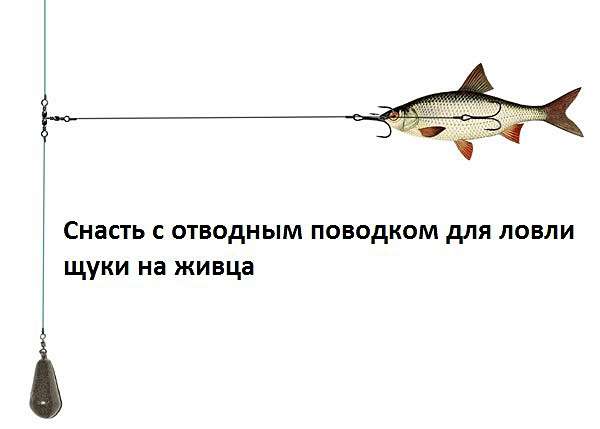
In this case, a braided cord or fishing line is used, having a diameter of at least 0.3-0.5 millimeters. In this case, their length should be approximately 20 meters.
A lead weight of 50-200 grams is attached to them, on a blind one - as securely as possible.
You also need to make loops to attach the Steel Leash. They are made on the main thread. The length of the leash itself varies slightly, from 20 to 40 cm. It is equipped with a triple or double hook.
It is customary to use a Bell or its Electronic version as a bite alarm.
Applying an Elastic Band Between the Warp Thread and the Weight.
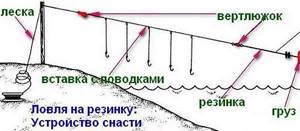
This type 2 equipment is also quite popular. If there is a need to change live bait, then there is no need to completely remove the used tackle from the water.
The secret of this trick is simple - the ability to stretch no less than 5-7 times. The exceptional elasticity of the elastic allows you to pull up and release the line during fishing without any problems.
Donka on the Rod Base Together with a Reel of the Inertialess Type or “ZAKIDUKHA”.
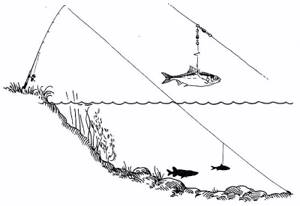
In principle, its assembly is almost completely similar to the modifications described above (sinker/metal leash/hook).
Promising Places for Pike Fishing on Donku
The choice of a place for fishing with donkey is determined primarily by the presence of so-called “Bottom anomalies”. These include, first of all, Slides, Sharp slopes from the edges and pronounced depth changes. This is where you should look for a predator.
As an option - areas of a reservoir (Lakes, Rivers) with the presence of snags, as well as the border of open, clean water with vegetation.
Bottom tackle for Live bait from the Shore. Video
Fishing Features
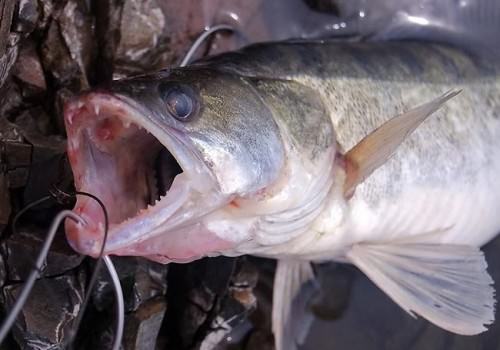
Seasonal features of fishing for predators:
- In December, for hunting pike perch, it is recommended to choose places with an abundance of snags and holes with a depth of 9-16 meters.
- In warm spring, pike perch approaches the shallows, which are located not far from deep holes.
- In the hot summer, the fish hides under trees piled into the reservoir or under boulders.
- During the autumn months there is a peak in toothfish biting activity. You need to look for it in areas of changes in depth and near steep banks.
In addition, there are several other features that should be taken into account when going fishing:
- When hunting for pike perch at night, you should not use flashlights or other lighting devices. The predator goes out in the dark in search of food and must remain in complete calm. Bright lights will only scare him away and he will leave the fished area.
- On reservoirs with strong currents, you will need the heaviest possible feeder and high-power tackle. This will allow you to successfully bring even trophy specimens to the shoreline and avoid rod breakage.
- When fishing from a boat, it is recommended to use specialized boat holders. Installation is carried out to the board, so there is no doubt about the reliability of the fastening.
Blitz tips
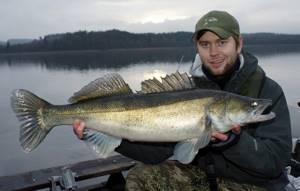
- It is necessary to bait live bait with wet hands , since too dry skin of the hands practically burns the body of the fry and it behaves quite sluggishly when entering the aquatic environment.
- You should choose a place for casting with minimal accumulation of grass and stones to prevent the bait from getting tangled. In addition, for active behavior the fry needs a large space where it can actively swim. Seeing a predator in front of it, the baitfish will begin to panic and flee to a safe place and with its behavior will only attract the attention of the pike perch.
- After each fishing, you should carefully inspect the hooks. Having good strength, pike perch can easily bend the sting, therefore, if you notice damage to the shape, you should replace the hook. A deformed product is not capable of self-cutting.
- Considering the extreme caution and attentiveness of the predator , you should maintain silence on the shore and, if possible, wear camouflage clothing.
- The fish bites quite actively and usually swallows the sting too deeply. To facilitate the process of retrieving the hook and not to injure the organs of the inhabitants of the aquatic area, it is recommended to use specialized forceps.
- If a fry that is in a half-dead state is served as bait , then the probability of a bite is reduced to zero.
